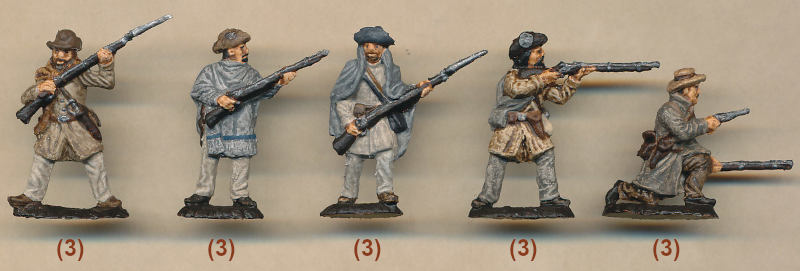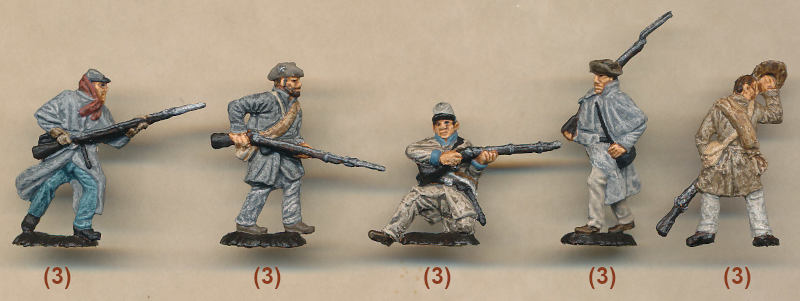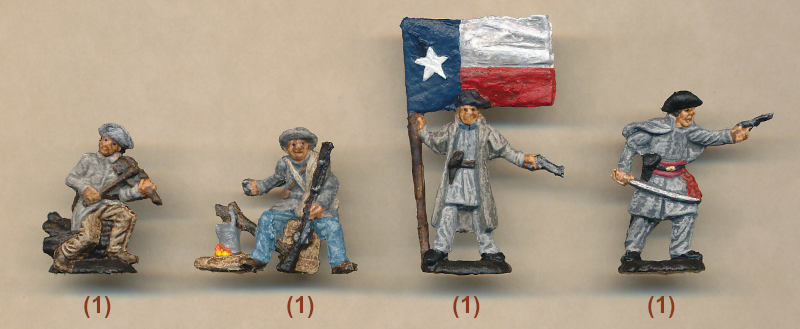
"Confederate Infantry Texas Troops Review" Topic
7 Posts
All members in good standing are free to post here. Opinions expressed here are solely those of the posters, and have not been cleared with nor are they endorsed by The Miniatures Page.
Please remember that some of our members are children, and act appropriately.
For more information, see the TMP FAQ.
Back to the ACW Discussion Message Board Back to the Plastic Figures Message Board
Areas of InterestGeneral
American Civil War
Featured Hobby News Article
Featured Showcase Article Sometimes at a convention, you can be just dead lucky and find a real bargain.
|
Please sign in to your membership account, or, if you are not yet a member, please sign up for your free membership account.
| Tango01 | 02 Aug 2022 2:53 p.m. PST |
"Despite its size, Texas had one of the smallest populations of the states of the Confederacy (only Arkansas and Florida were smaller), and being in the western part of the country, it's troops naturally concentrated on campaigns in the Western Theatre. However, it also provided troops for the Eastern Theatre, most notably in Hood's Brigade, which was highly regarded and considered as providing shock troops for Lee's Army of Northern Virginia. No serious action took place within Texas itself, but over 70,000 Texans served in the Confederate Army during the war, which is an impressive figure when you consider that the total non-slave population of the state, men, women and children, was just over 420,000 at the time. The majority of this contribution was cavalry, since there was a very high familiarity with horses, but many regiments of infantry were also sent to aid the Southern cause, and some cavalry units were converted into infantry as the greater need was for foot soldiers…"



Full Review here
link
Armand |
Shagnasty  | 03 Aug 2022 7:52 a.m. PST |
No major actions but some interesting minor ones: 1) Texas troops humiliated the US Navy at the battles of Galveston and Sabine Pass. 2 The last "battle" of the war was a Union defeat at Palmetto Ranch #) The CSS "Alabama" lured the similar sized USS "Hatteras" 20 miles from the blockade of Galveston and sank her. |
| doc mcb | 03 Aug 2022 7:53 a.m. PST |
Most of that cavalry fought as infantry. Lee had a single Texas brigade, and the Army of Tennessee had maybe two brigades. Walker's division that fought in Louisiana was all-Texas, iirc. There were no large battles in Texas because we didn't let them in. |
| doc mcb | 03 Aug 2022 7:57 a.m. PST |
Walker's Texas Division, C.S.A.
Greyhounds of the Trans-Mississippi
By: Dr. Richard Lowe Description: Colorfully known as the "Greyhound Division" for its lean and speedy marches across thousands of miles in three states, Major General John G. Walker's infantry division in the Confederate army was the largest body of Texans – about 12,000 men at its formation – to serve in the American Civil War. Walker's division remained, uniquely for either side in the conflict, a stable group of soldiers from a single state from its creation in 1862 until its disbandment at the war's end. Richard Lowe's compelling saga shows how this collection of farm boys, store clerks, carpenters, and lawyers became the trans-Mississippi's most potent Confederate fighting unit, from the vain attack at Milliken's Bend, Louisiana, in 1863 during Grant's Vicksburg campaign to stellar performances at the battles of Mansfield, Pleasant Hill, and Jenkins' Ferry that helped repel Nathaniel P. Banks's Red River campaign of 1864. Lowe evokes the trans-Mississippi theater, with its battles in the hills, prairies, and swamps of Arkansas, Louisiana, and Texas – vitally important and influential in the war's course even though outdazzled by eastern landmarks such as Gettysburg and Antietam. The author makes vivid the growing challenge that confronted the Confederate cause in 1862 and gave rise to the Greyhounds. Using a database of information collected on 2,200 soldiers, he calculates that Walker's enlisted men were somewhat older, more likely to be married, and more often heads of households than their counterparts, both Rebel and Yankee. Their financial assets and casualty statistics mirrored those of Texans generally, casting doubt on the slogan "a rich man's war and a poor man's fight." And although the Confederacy may have erred in not sending the division east of the Mississippi River to fight in larger campaigns, Lowe's book yields the poignant conclusion that the Greyhounds were content to remain where they were to shield their families from an invading enemy and the devastation of war. The only modern history of these soldiers, Lowe's study is also a rarity in its scholarly examination of an entire Civil War division. Moreover, his skillful blending of narrative drive and demographic profiling represent an innovative history of the period that is sure to set a new benchmark. |
| doc mcb | 03 Aug 2022 7:58 a.m. PST |
link Wiki article has order of battle. |
| Tango01 | 03 Aug 2022 2:19 p.m. PST |
|
Texan Phil McBride  | 25 Nov 2022 6:59 a.m. PST |
Nice to see the Texas Confederate minis pictured. And thanks to my brother John --docmcb--for posting the good summary of Walker's All-Texas Division, Walker's Greyhounds. I've written an historical novel about one of the member regiments--the 17th Texas Vol. Inf. The title is With Might & Main, and can be found here on Amazon.
link
If you are a Texas in the Civil War nut or like a compelling tale of the common citizen-soldiers in the, you might find With Might & Main to be a good read. |
|

